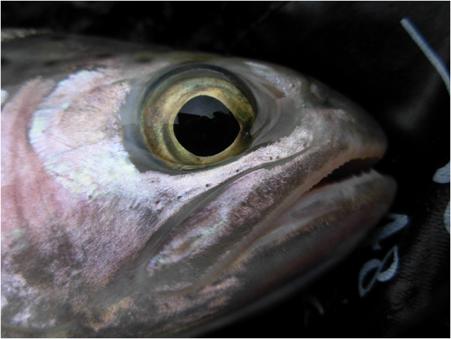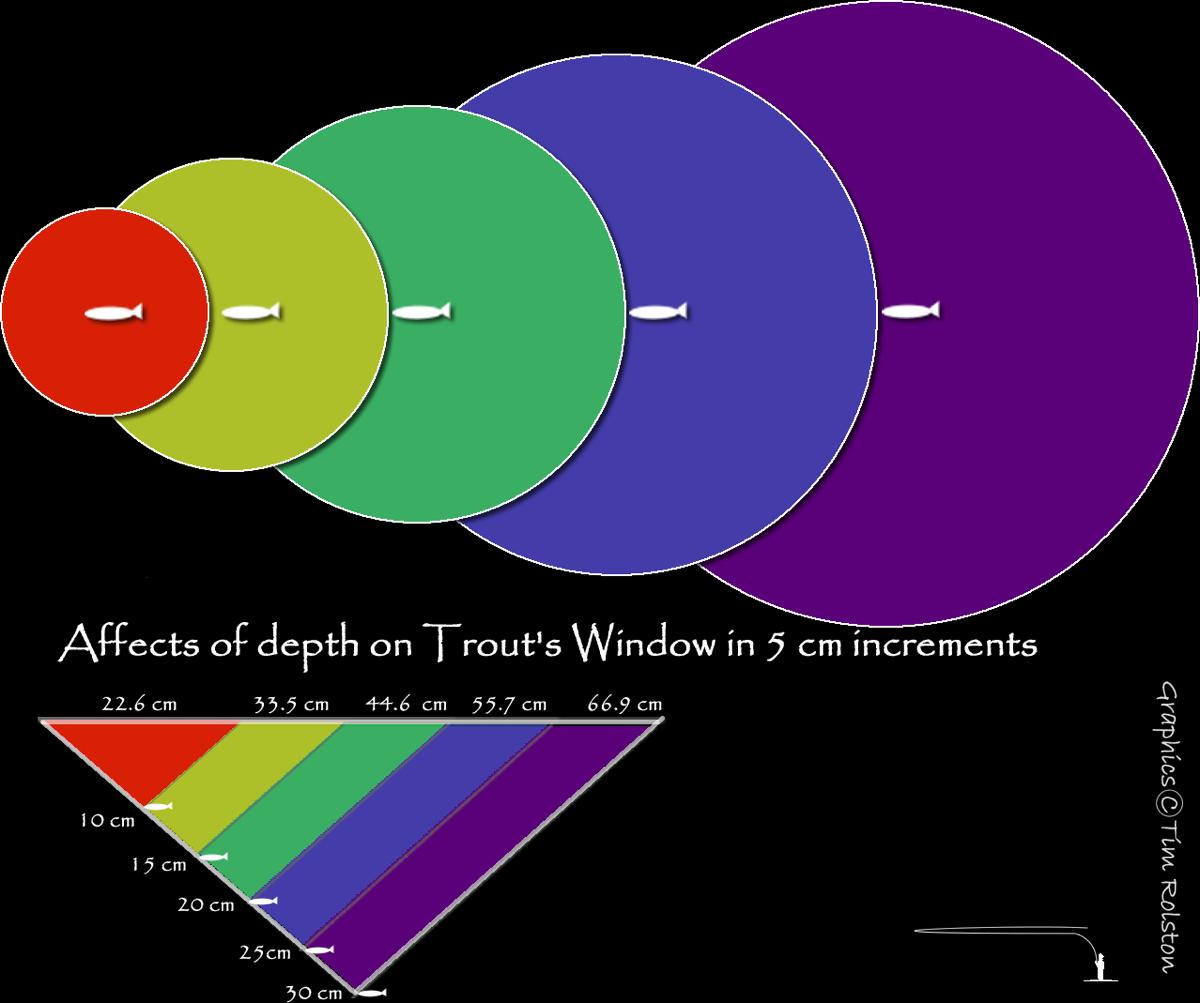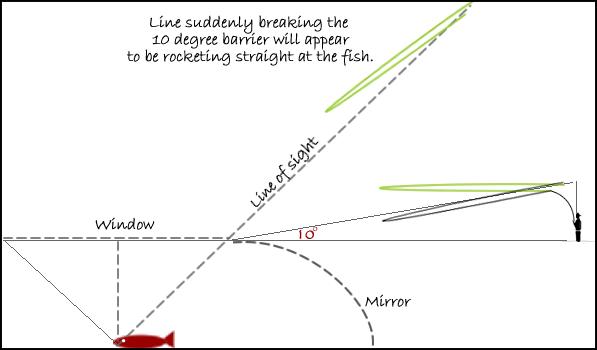
11 minute read
My Mistress' gaze by Rob Pretorius
(With images by Tim Rolston)
Do you ever gaze longingly into your true loves eyes? I know I do, but over time I have come to realise she does not see me the same way as I see her. Now, for some, this might be a problem but for me it just comes down to nature and, more specifically, biology.
Advertisement
The one true love I’m speaking of is of course trout. I work with trout all day at Giants Cup Hatchery, obsess over making flies by night and in my spare time I try connect with them via spiderweb thin monofilament. So, yes, I truly love these fish and I am going to try to help you find your match in this watery dating world by the only way we know how - deception, otherwise known as flyfishing.
How do trout see our flies? This is something all flyfisher people and especially fly tiers should be concerned about. Interestingly, most fisher people and fly tiers that I’ve interacted with have not given it all that much thought. I will admit, I only really looked a bit deeper into the biology of the trout eye when cramming for an aquaculture exam. After the exam was over I got back to the important things in life, namely flyfishing and fly tying. I tinkered with my fly patterns, applying my new found eyeball biology knowledge and guess what? I started to catch more fish. I am going to attempt to share this knowledge, without completely nerding out on you.
Trout have an elliptical shaped orbit, that allows them to have a focal point in front of them as well as on their sides simultaneously. If you look at the photograph of a sexy rainbow trout eye you will see this clearly. I
www.saflyfishingmag.co.za 9 always wondered why the pupil was not spherical like ours and at first I thought it might just be that the fish that I was looking at was a bit “special” but, no, it’s just the way nature designed these beautiful sleek creatures.
It actually makes sense, if you think about it. They can key in on food items in front of them by using their sharp field of vision while still having fantastic peripheral vision to look out for predators and any food item that might need closer inspection with their forward-facing binocular vision. There is a notch in the forward edge of a trout pupil that helps them see over the bridge of their nose.
The ovoid shape of the trout eye allows for two simultaneous focal lengths—one to the front for near vision and to the side for far field vision. Both are in clear focus at the same allowing trout to eat with discrimination and remain on the lookout for predators or anglers. (Thomas Barnett/Courtesy of Stackpole books)

Having these two focal lengths in focus simultaneously is like having our peripheral vision in focus at all times.
This means that trout are near-sighted to the front and far sighted to the sides. No geeky spectacles needed for these beauts and this is why it can be so difficult to get close to trout - they are very wary of aerial predators like fish eagles, herons, kingfishers etc. If you watch competitive anglers on the river they will keep an incredibly low profile and don’t false cast much fly line in an attempt to minimise their above water profile. This is a tactic to try to stay outside of a trout’s vision window and stay undetected so as to not spook the fish.
Trout lack eyelids so they can’t flutter their eyelids at us to try and catch our attention at the bar, but this also means we need to take extra care when we get physical with them. The cornea (outermost part of the eye) is susceptible to abrasion from our net or hands.
The risk of eye injury increases if you lay fish on the grass, or worse, the bottom of the boat so please try be mindful of correct trout handling. Remember to #keepemwet or, if you absolutely need to take a photo, keep them out of the water for as short a time as possible as their eyes start to dry out very soon after they have been removed from the water. Also keep fish out of direct sunlight if possible as they cannot regulate the light entering their eyes the way we can.
A trout’s retina has the same photoreceptors as humans have; these being rods and cones. Rods are responsible for most of a trout’s nocturnal vision as they are very sensitive to light. Cones on the other hand are responsible for colour detection - red green and blue. Interestingly, most often only one set of receptors is used at a time. During the day cones are used to see colour and the rods are retracted into the retina to protect them from harsh sunlight while at night the light sensitive rods are used. Only d u r i n g d a w n a n d d u s k a r e t h e y simultaneously used and an overlap occurs.
What does this mean for us anglers? Well if you plan on fishing at night select flies with a definite silhouette and contrast to the natural world. Trout effectively have their own form of night vision. The old axiom, “dark fly, dark day, light fly, light day” is is holds its own in the face of science. trying to catch them they have already lost the ability to see in the UV portion of the light spectrum.
According to Dr. Iñigo Novales Flamarique, one of the world’s leading researchers on trout vision, “As for the use of ultraviolet vision in young salmonids (with UV cones), the UV cones enhance the contrast of zooplankton prey and improve the fish’s foraging performance. Nothing is known about the function of UV vision in salmonid fishes at later stages in nature, and it is doubtful that it serves any ecological purpose once the UV cones are gone”.
The Biology of a Trout Eye
Light enters the trout’s eye through the pupil, which is a hole in the iris, and then passes through a clear lens that focuses it upon the retina, which is the actual light sensitive surface. Changing focus from distant objects to near objects is done by moving the lens closer or further away from the retina. Adjustment to light intensity is achieved through the depth of light sensitive cells in the retina. As they have large diameter fixed pupils much of whatever light that is in their surroundings in admitted to their eyes. This may be one reason why trout avoid brightly lit areas.
Window of vision
Debunking the UV Myth
This is something that has bothered me for a long time as there is conflicting literature regarding the ability of trout to see in the UV portion of the light spectrum.
Trout have the ability to see UV up until they reach the parr stage (which is only a few inches in length) and after this they lose their ability to see in the UV portion of the light spectrum. The dedicated cones that are responsible for them to see UV light have by this time changed to be able to see in the blue portion of the visible light spectrum. This means that by the time they are at a size that we as anglers would be concerned about The window of vision is what the fish has the ability to see. The following diagrams show what this window looks like.
For more on this visit Tim Rolston's blog, (https://paracaddis.wordpress.com/tag/ trout-vision/
Trout have both binocular and monocular vision. Binocular vision is when both eyes focus on an object at the same time. Monocular vision is peripheral vision where each eye works independently of the other. Whereas trout have very good monocular vision their binocular vision is not not as good as, for example, yours.

A relatively small increase in depth can result in a substantial increase in the size of the trout's window. For example, doubling the water depth from 0.5m deep to 1.0m deep effectively quadruples the size of the window.

The trout’s depth of field, to use a photographic term, is very shallow. Objects only come in to perfect focus in a trout’s vision when they are approximately five centimetres in front of the fish. Their longdistance vision is therefore not great underwater.
The biology of a trout eye is such that it does not allow it to see in great detail, so for this reason our flies do not need to be exact replicas of the naturals. Shape, size, colour a n d m o v e m e n t a r e o f f a r g r e a t e r importance to the fish than matching the finer details of the naturals that we imitate.
Colour vision
I often get asked if trout are colourblind the short answer is “no”. Trout can see in colour, there is no doubt about that. They use the colour sensitive cones on their retina to detect colour.
There are three subsets of cones that detect red, green and blue light respectively. The colour that the fish perceives is not the same as we might when our flies come off the vice, so it is a bit like being blind while selecting the coloured materials for our flies. We have a rough idea of what our flies should look like in the water but no real idea of how the fish will perceive the fly.
For this reason I like to experiment with different colours and try and draw conclusions as to why certain colours work better than others. I also wonder whether all fish see colour the same way or if there is a variance within a population in the same way within a human population that some individuals cannot distinguish between red and green.
Blindspots
Trout have blindspots in their vision; this is something that most river fishermen use totheir advantage by fishing from a downstream position and casting upstream. Trout have a 30 o blind spot behind their tail and a small blind spot just in front of their nose. Now this may sound too good to be true but remember that trout are not all facing in the same direction and if the fish turns slightly it will most likely see you in its

Photo #1 is a colour board from the perspective of a trout if it were one foot below the water’s surface and six feet away. Photo #2 is at the same depth, but 12 feet away. Photo #3 is at the same depth, but 20 feet away. The author’s wife is easily visible in the first photo, compressed but visible in the second, and nearly invisible in the third. The lesson is a crouching angler is easy for a trout to see from 12 feet away and probably unrecognisable from over 20,

enhanced (by our standards) peripheral vision.
Trout see best in front and above them and it is for this reason that it makes sense for us to present our flies in such a way that the fish can best see them. I often see fisherman dredging the depths of still waters with very limited success. This is because it is far easier for a fish to see above rather than below itself. Keep this in mind next time you present a fly to a trout in an attempt to hook them for your next fishy date.
Trout Environment / Water as a Visual Medium
Like the coloured hippy sunglasses often worn at music festivals like Splashy Fen, water will affect a trout’s vision in the same way. The water column effectively puts a tint on the colours that the fish can perceive by either filtering out certain wavelengths or accentuating others. For example, water in the blue ocean turns red into a muddy brown and yellow often stands out in freshwater environments, whereas green-stained water favours shades of green.
Contrast is often the trigger that the fish are after in your fly. If you look at most naturals they are not monotone in appearance and the dorsal side is normally darker while the ventral side is lighter in appearance.
The top of the colour board in photo #1 shows the colours of the rainbow and the bottom shows white, black, and fluorescent yellow and orange under natural sunlight. Photo #2 shows the same colours submerged in fresh water, which accentuates the yellows but dulls the blues. Photo #3 shows the same board submerged in a stillwater pond with green-stained water where the blues turn to black and reds to brown. Photo #4 shows fluorescent colours show up well in nearly any condition, even in heavily-stained water.

The pineal gland is situated on top of the brain just below a portion of the skull th for partial light transmission. It helps the trout to keep in rhythm with daily and seasonal cycles.
This gland also functions as a shadowdetector to alert the trout to threats from above. Fish that have lost complete vision in both eyes will still react to shadows passing over them from above. This I have witnessed firsthand in the hatchery and is quite bizarre to see.
This is defiantly not an exhaustive account of how a trout perceives its world and I have left out entire aspects related to trout vision. I may touch on those aspects in a later article.
The information that I have shared is what I found to be the most interesting and mostly unknown in the fishing community. I'm hoping that these dating tips will help you connect successfully with your rainbow or brown would-be lover.











